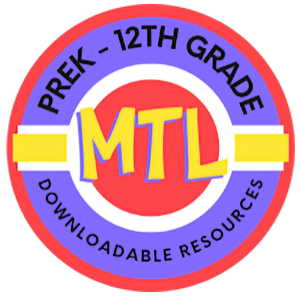Showing all 8 resultsSorted by latest
-
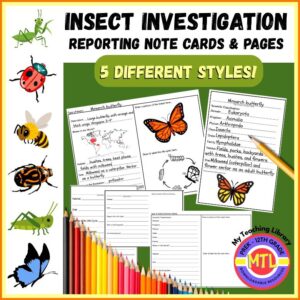 $3.00Buy Now
$3.00Buy NowStudying insects? Doing a unit on entomology? Give students a resource to help guide an investigation as well as report what they find!
This product includes 5 different styles of insect investigation note cards and pages making it adaptable for multiple grades/levels. Depending on the information that you want students to gather and report, choose the appropriate style for the assignment. Once given the note card or page, the topics on each will help guide students as to the information they need to find and complete!
Details:
Style 1: (1/2 page note cards – 2 per page) Name of insect, habitat, diet, stages of the life cycle, role in the ecosystem and an interesting fact. Students will also draw a picture of the insect.
Style 2: (1 page) Name of insect, description, where in the world (map given to complete), habitat, diet, role in the ecosystem and an interesting fact. Students will draw a picture of the insect as well as draw and label the life cycle.
Style 3: (1/2 page note cards – 2 per page) Name of insect, scientific classification, habitat and diet. Students will draw a picture of the insect.
Style 4: (1 page) Name of insect, scientific classification, where in the world, habitat, diet, role in the ecosystem. Students will draw a picture of the insect as well as draw and label the life cycle.
Style 5: (1/4 page note cards – 4 per page) Name of insect, habitat, diet, stages of the life cycle, role in the ecosystem and an interesting fact. Students will also draw a picture of the insect. -
Sale!
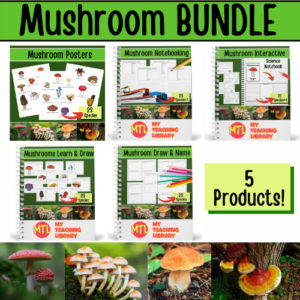 Buy Now
Buy Now$15.00Original price was: $15.00.$12.00Current price is: $12.00.My Teaching Library has bundled 5 MUSHROOM products to help you SAVE and have a variety of fantastic classroom resources to help you teach…
- – If you teach Science for 6th-12th grades, this bundle is for you!
- – If you teach an outdoor nature-based class, this bundle is for you!
- – If you want to give your student(s) a fun, research-based unit study, this bundle is for you!
-
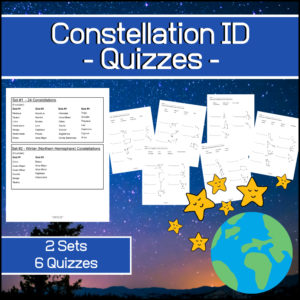 $2.50Buy Now
$2.50Buy NowUse this resource, Constellation Quizzes, to assess student knowledge of the imaginary star outlines or patterns on our ‘celestial sphere’ or they can be used simply as worksheets during the learning of the constellations! I’ve included 2 sets (with a total of 6 quizzes).
Each quiz will give students pictures and names of constellations and students will need to identify (match) each.
-
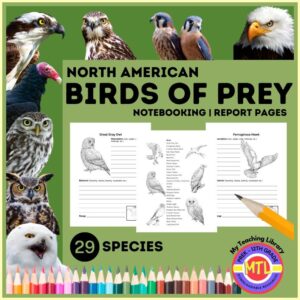 $8.00Buy Now
$8.00Buy Now‘North American Birds of Prey’ is a 41-page resource designed to help students organize and present reports for each 29 different birds of prey species!
Each species-specific page includes the name of the bird, an illustration and the following sections: description (size, weight, color, markings, etc.), behavior (breeding, nesting, feeding, vocalization, etc.) and range plus a map of North America.
In addition to the species-specific pages, there are ten additional pages on which students can included additional information, draw their own illustrations, plus add additional species to their projects.
Use alone or add to your lessons: North American Birds of Prey Cards
This resource includes pages for the following birds:
• Great Gray Owl
• Ferruginous Hawk
• Common Black Hawk
• Red-Tailed Hawk
• Barred Owl
• Barn Owl
• Short-Eared Owl
• Prairie Falcon
• Swainson’s Hawk
• Snowy Owl
• Turkey Vulture
• Eastern Screech Owl
• Burrowing Owl
• American Swallow-Tailed Kite
• Elf Owl
• Osprey
• American Kestrel
• Peregrine Falcon
• Bald Eagle
• Northern Goshawk
• Merlin
• Golden Eagle
• Northern Harrier
• Northern Saw-Whet Owl
• Crested Caracara
• Great Horned Owl
• Sharp-Shinned Hawk
• Harris Hawk
• Long-Eared Owl -
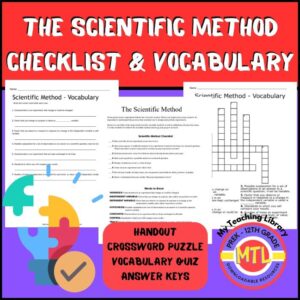 $2.50Buy Now
$2.50Buy NowBefore students begin a science project, it’s important to know important vocabulary and understand the process scientists use to design and perform experiments. This resource includes:
- Handout with a scientific method checklist (step-by-step process to follow)
- Seven vocabulary words with definitions
– Variables
– Independent variables
– Dependent variables
– Hypothesis
– Constants
– Control
– Trials - Vocabulary crossword puzzle (with key)
- Vocabulary quiz (with key)
To use again and again, laminate or place inside a sheet / page protector!
-
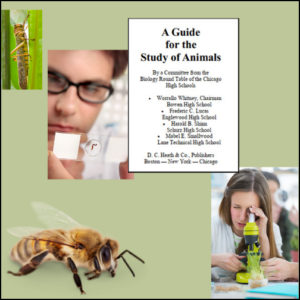 $2.50Buy Now
$2.50Buy NowThis is a downloadable copy of the book. (138 pages)
About the book: A Guide for the Study of Animals is a classic zoology guide (1911) which is intended for pupils in 9th-12th grades. It was prepared by the authors at the request of the Biology Round Table, an association composed of the teachers of Biology in the Chicago High Schools. The book is basically a Biology / Zoology Lab activity guide. Please note that this is not a ‘textbook’ but a lab activity book. (See description for further details.) -
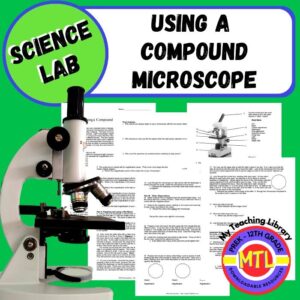 $3.00Buy Now
$3.00Buy NowThis is a complete, step by step science lab during which students will learn about, use a compound microscope and record their observations as well as important facts they’ve learned.
Key highlights covered:
- – Parts of a compound light microscope and their functions
- – How to calculate magnification
- – How to make a wet mount slide
- – Detailed information on how to use the microscope
-
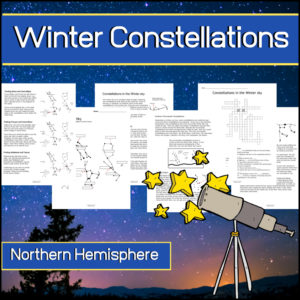 $3.00Buy Now
$3.00Buy NowExplore the Northern Hemisphere’s Winter constellations with this resource! Students will learn…
- What are the major constellations?
- What is the Greek Mythology behind them?
- What major stars will help guide them through the night sky?
- How is Orion the ‘key’ to locating the main constellations?
- What is the name of the North Star, and which constellation is it in?
- What is the brightest star in the sky?
Students will learn about the following constellations:
- Orion
- Canis Major
- Canis Minor
- Gemini
- Auriga
- Pleiades
- Taurus
- Draco
- Ursa
- Major
- Ursa Minor
- Cepheus
- Cassiopeia
They will learn the location of the following stars:
- Pollux
- Castor
- Capella
- Procyon
- Sirius
- Betelgeuse
- Rigel
- Aldebaran
- Capella
- Polaris
They will also learn which constellations are called the Northern Circumpolar constellations PLUS the Greek Mythology behind these major constellations!
Student activity sheets include:
- Fill in the blank (constellation and star names for the ‘Winter Sky’)
- Draw and name (the five circumpolar constellations and the North Star)
- Crossword Puzzle (in which they will use the information within the resource to gather answers)
Suggested follow up activities:
- Assign students to go outside after dark, find and draw the constellations they see and can identify.
- Visit a local planetarium
